
They’re more than just for spritzers or to satisfy your sweet tooth. Crisp, tart, aromatic and expressive, the different white wine flavor profiles are as much of a journey for your palate as they are a tour around the world. However, many still assume that all white wines are too flat, too sweet — or worse — somehow not as sophisticated as reds. Pairing your white wine correctly can improve the experience you have with white wine as well. Take our Wine Pairing Quiz and find the perfect pairing for you!
Every wine-growing region around the world cultivates white wine grapes for a reason. With hundreds of varietals and variations, each of the many kinds of white wine showcases various smells, sights and tastes unmatched by other drinks.
What Is White Wine?
Wineries make white wine by using over 20 different types of white grapes. Around 90% of grapes cultivated in the world trace back to a single grape varietal known as Vitis vinifera. While the original Vitis vinifera grapes were black, a genetic mutation occurred that led to the existence of the white grapes that we now use to produce most of the white wines you know today.
Wineries remove most white grapes’ stems, seeds and skins before the fermentation process. This process differs from red wine, which leaves the seeds and skins intact and also often incorporates the stems. The parts of the grape that winemakers remove for white wine have high concentrations of tannins, so white wines typically have a much lower tannin level than red wines. The high tannins in many red wines cause the dry-mouth feeling that most either love or hate.
White wine drinkers love their refreshing and tart acidity, floral aromas and fruit-forward nature. While most vineyards age their white wine in stainless steel vats to preserve the floral and fruity notes, others, such as chardonnay, age in oak to develop a nutty taste and creamy mouthfeel. Winemakers use various techniques to produce white wines, so you can find whites that range from tart and light-bodied to a more full-bodied dry white. White wines are incredibly versatile. Some, such as viognier, can pair well with fruit, while others like pinot blanc can stand up against heavy red meats.

What Are the Different Types of White Wine?
Our overview of white wines is here to change such misconceptions and encourage you to try something new. From everyday favorite picks to niche varietals even white wine experts don’t regularly see, we’ve put together a summary of the main types of white wines, as well as what to look for in a glass and ideal food pairings.
1. Chardonnay
Pronounced “shar-duh-nay”
When most people think of white wine, they typically conjure the smells, flavors and features of one of its textbook classics: chardonnay.
Chardonnays are a model varietal to top the list of white wine types. Native to the legendary Burgundy regions of France, this green-hued grape grows universally today but thrives in colder climates such as the Pacific Northwest, New Zealand and South Africa. Some of today’s most popular chardonnays come from Napa and Sonoma Valley, readily accessible for passionate and novice white-wine drinkers alike.
Chardonnay-growing vineyards rely upon many fermentation tweaks to soften the grape’s natural acidity into gentler, silkier notes. Most prominent is the malolactic method, which is responsible for adding chardonnay’s noticeably light and creamy aftertaste. Many have even likened this white wine’s type’s flavor to butter or toffee.
You can expect pops of green apple, lemon, pineapple and celery in your chardonnay, rounded out by the candy-like coconut or caramel finish. Chardonnays can fall on the sweeter or dryer side depending on the type, though their unique finish helps keep it from becoming too flat or dessert-like.
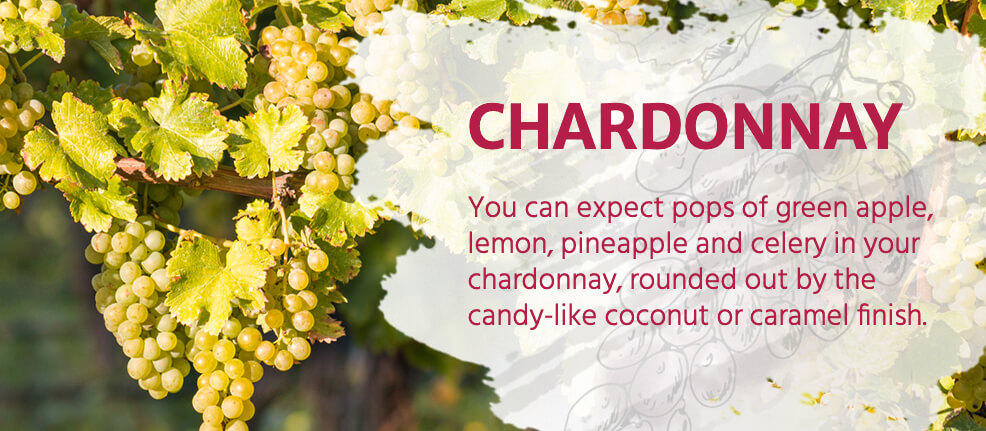
If you’re interested in a more fruit-forward, light chardonnay, opt for a bottle that states “unoaked” or “no oak.” Likewise, those smooth, buttery finishes will come more prominently in Old World chardonnays that have oak-aged, per tradition.
A glass of chardonnay does wonders with the following foods:
- Pasta with olive oil or garlic butter-based sauces
- Semi-soft white cheeses, such as fontina, chevre and halloumi
- Peas and edamame
- Fish like halibut, trout and sturgeon
- Turkey breast
- Tempeh and seitan
- Most nuts, but especially almonds and cashews
2. Riesling
Pronounced “reece-ling”
Riesling, another popular type of white wine known worldwide, offers a diversity of flavor profiles that can suit nearly any drinker’s tastes. That’s because this white wine varietal comes in many forms, from the late-harvested sweet Mosel Valley varieties to their dryer, crisper French and Washington State riesling counterparts.
Riesling grapes are highly fragrant. Winemakers can manipulate them for tart ripeness or hold them on the vine for a more refined, longer-lasting finish. Either way, rieslings maintain a sharp, highly acidic and fresh, non-lingering body, whether winemakers make them sweet or dry.
Rieslings are generally on the thinner side, not high in alcohol and not likely to overtake the tastebuds when sipping alone or pairing with food. They do best without much fermentation or oak influence during the aging process, making this a slightly different white wine varietal in that winemakers can harvest, bottle and leave rieslings to age without much fuss.
This type of white wine carries notes of honey, lime, apricot, green apples and earthy minerals. The older the bottle, the dryer and deeper the flavors tend to run, as riesling grapes ripen quickly on the vine and can’t fully develop naturally complex flavors. Serve riesling on the chilled side, between 45 and 50 degrees Fahrenheit.
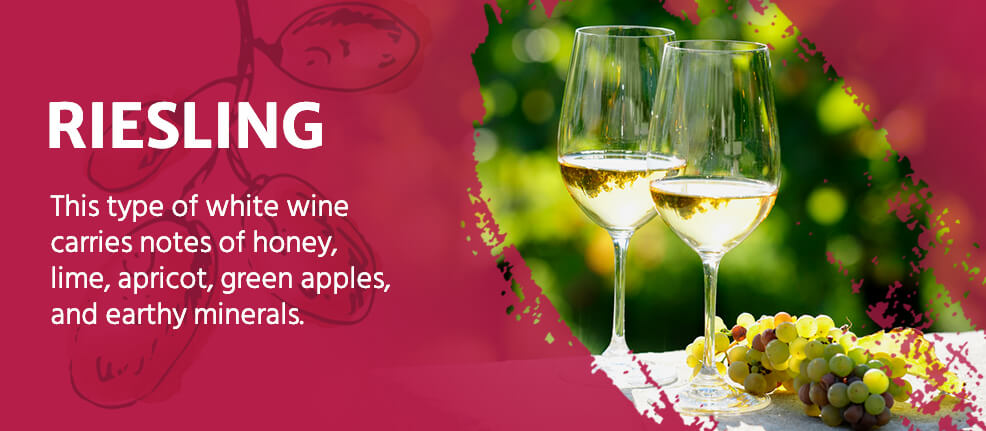
The zippiness and lightness of rieslings go well with the following snacks and meals, especially highly spiced or ethnic dishes:
- Thai and Indian curries
- Bahn mi sandwiches
- Miso soba and udon noodles
- Chips with salsa or guacamole
- Traditional German spaetzle
- Dumplings
- Sesame chicken
- Fish or shrimp tacos
- Pork mains
3. Pinot Grigio/Pinot Gris
Pronounced “pee-know gree-jhee-oh” and “pee-know gree”
This white wine is called something different, depending on where it’s made. Pinot grigios and pinot gris are the same grape varietal grown from the same grape mutation. The naming confusion merely arises from language, as Italians cultivate and call it grigio, while their neighbors to the north — the French — dubbed it the shortened gris.
Pinot grigios are incidentally a younger cousin to the similarly named pinot noir, a wildly popular red wine type. The two carry complementary olfactory notes – dry, woodsy and even floral on the nose. Interestingly enough, pinot grigio and pinot gris grapes are a foggy gray-purple color — a surprising twist for a white wine varietal that harkens to its red origins.
Pinot grigios carry a distinctly heavier texture compared to other white wine types on the list. Sips will coat your tongue with an oilier, velvety feel best described as buttery. This heavier body doesn’t necessarily mean a more decadent drink, though, as grigios and gris still contain the light, bright notes for which white wines are notorious. It merely turns up the dial, asserting the earthy with the sweet and finishing with a refreshing rather than in-your-face tartness.
Those who enjoy heavier-bodied wines with a slightly less fruit-forward palate will appreciate pinot gris. A typical glass will have notes of lemons, white nectarine, jicama, clove and ginger. Serve pinot grigios and pinot gris “cold,” around 45 degrees Fahrenheit.
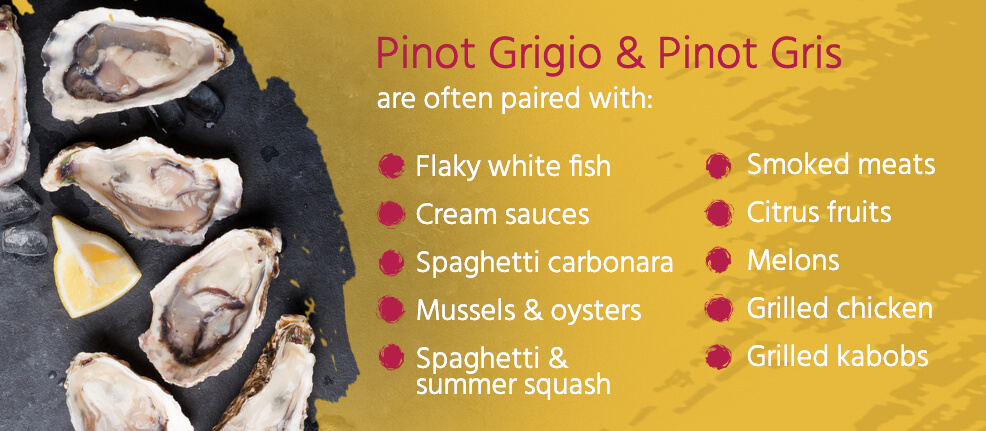
The semi-dry and expressive flavors of pinot grigio combined with its long-lasting tang pair perfectly with the following foods:
- Flaky white fish like tilapia, sea bass and sole
- Cream sauces
- Spaghetti carbonara
- Mussels and oysters
- Spaghetti and summer squash
- Smoked meats, particularly salmon
- Citrus fruits, especially pineapple
- Melons
- Grilled chicken
- Grilled kabobs, meat or vegetarian
4. Pinot Blanc
Pronounced “pee-know-blahnk”
Continuing down the pinot family line, next on the list of white wine types is the pinot blanc.
Famous in its home region of Alsace, France, and neighboring Austria, Italy and Germany, this white wine varietal is among the naturally dryest and most round-bodied in the family. While grigios/gris get lauded for their expressive pops of isolated flavors, a pinot blanc takes its time, with a medium-bodied presentation that blurs between sweet and smoky.
The flavor difference with this type of white wine is a crucial qualifier. While still incredibly light, pinot blancs contain a notable muskiness, both on the nose and the tongue. The best pinot blancs will even take on nutty notes, as well. Their medium bodies don’t overwhelm with their unique mix of heavy and light flavors, however. You’ll find a glass of pinot blanc carries bits of pear, lemon and yellow apple mixed with star anise, walnuts, applewood and mulch.
Pinots blancs finish on a slightly sour note due to their stable levels of acidity. Oak-barrel aging can tame this, which is a conventional treatment in pinot blancs from the United States, Canada and Argentina. Lighter versions aiming to stress the fruity and sour notes will skip any oak aging, though. Blancs with this treatment traditionally come from northwest Italy, go by the name pinot bianco and have a lighter, brighter finale.
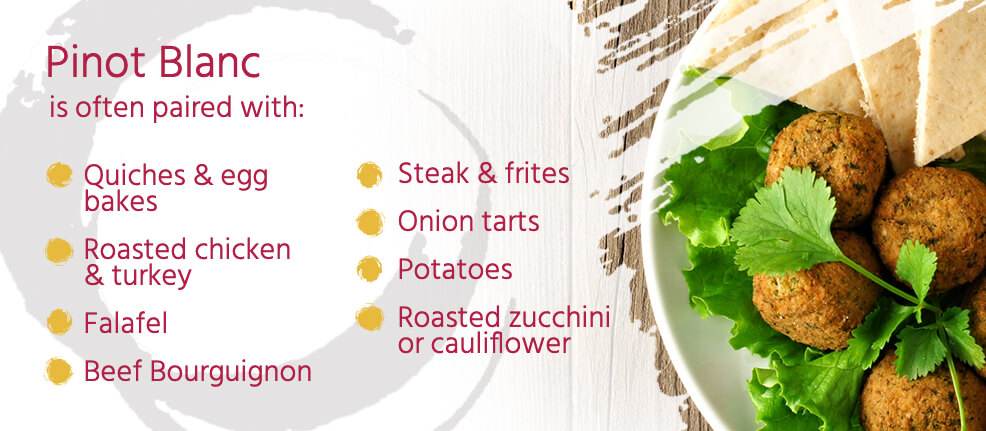
Altogether, the pinot blanc makes for a delightful white wine with equally expressive fruit and wood notes. While it is fresh and flavorful, it doesn’t aggressively linger on the tongue. Pinot blanc is fit for dishes it won’t have to fight against, such as:
- Quiches and egg bakes
- Roasted chicken and turkey
- Falafel or other chickpea-based dishes
- Beef bourguignon
- Steak and frites
- Onion tarts
- Baked, scalloped or mashed potatoes
- Roasted zucchini or cauliflower
5. Sauvignon Blanc
Pronounced “sah-vihn-yohn blahnk”
People have strong opinions about sauvignon blanc. The reason? While the word “blanc” translates from French as “white,” it’s one of the greenest-tasting types of white wine out there.
It’s also one of the world’s most heavily planted, leading to a wide range of those proverbial earthy smells and sips. With some of the highest acidity levels and punchiest fruit notes, you’ll taste everything from grapefruit to fresh grass cuttings, elderflowers to marjoram, green pepper to tomatillo in a single sip. However, that sip will finish dry.
New World sauvignon blancs tend to be slightly more fruit-forward than those cultivated in France. This type of white wine varietal has taken particularly well to the cooler slopes of New Zealand’s vineyards’ cooler slopes, where sauvignon blanc accounts for 58% of the country’s wine acreage.
The younger the blanc, the heavier the green or herbaceous notes — regardless of a vineyard’s country of origin. This varietal yields more pronounced and heavy-bodied waves like nectarine and peach to round out the savory notes when you allow it to ripen further.
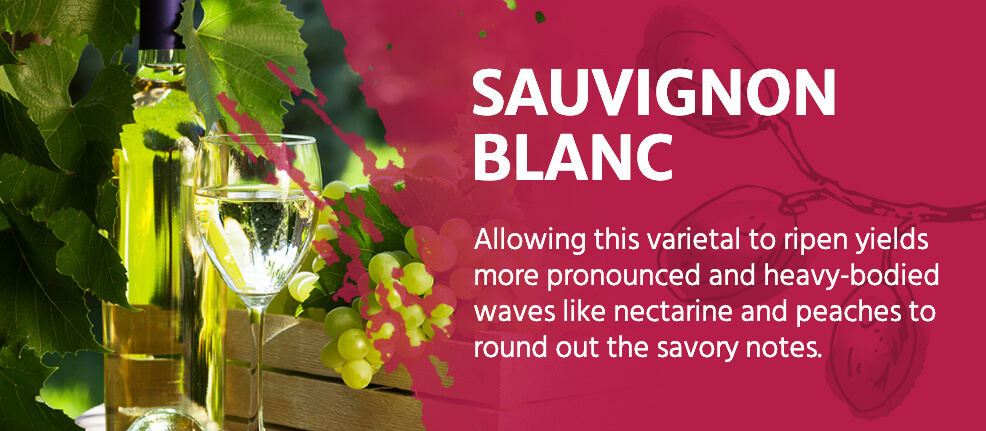
Overall, the best sauvignon blancs keenly balance the two — herby with fruity, silky with sour and intensely flavored with quickly finished. They continue to be one of the most popular and common types of white wines on the market today.
Consider pairing your next bottle of sauvignon blanc with any of these foods:
- Mushroom risotto
- Pesto
- Vinegar-based barbecue sauces
- Pasta and potato salads
- Minced or ground meats
- Blue cheeses
- Green fibrous vegetables, like asparagus and Brussels sprouts
- Hummus and cucumber sauces
- Mint ice creams and mint chocolates
6. Gewürztraminer
Pronounced “guh-veerts-trah-meenor”
You may not be able to say its name 10 times fast, but you can still enjoy this abundantly flavorful, albeit under-the-radar, white wine type — leaving you tongue-tied in more than one way.
When it comes to taste, few wines are as tangy and floral as gewürztraminers. Even some of the most fervently popular types of white wine varietals, renowned for their sweetness, don’t compare to the juiciness and garden-like flavors you’ll get in a glass of this French-German noble grape.
Like the name might tease, gewürztraminers have a highly distinctive set of flavors and scent profiles that draw you in even while you’re pouring a glass. Gewürztraminers are inherently aromatic grapes that trick the senses into thinking they’re sweeter and less acidic than reality, with some complex results.
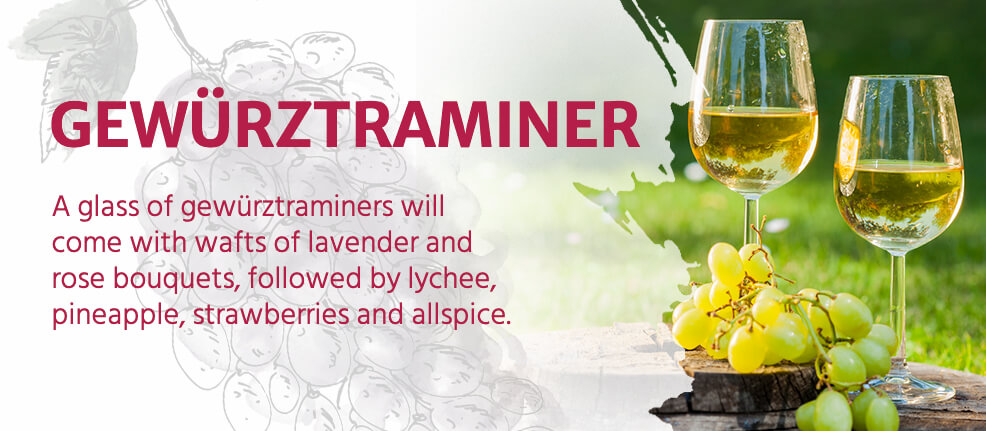
A glass of gewürztraminers will come with wafts of lavender and rose bouquets, followed by lychee, pineapple, strawberries and allspice. It is an ultra-light, refreshing and pleasantly spiced white wine perfect for drinking on a warm summer afternoon.
Enjoy a fragrant glass of gewürztraminers with these equally vibrant and well-seasoned mains:
- Fatty meats, like bacon and salami
- Moroccan-spiced lentils and couscous
- Sweet-and-sour chicken
- Beef satay with peanut sauce
- Sushi
- Madras curry
- Chilis
- Roasted eggplant
- Creamy soups
7. Moscato/Muscat
Pronounced “muh-skot-toe” and “muh-skot”
It may be the darling of sweet-toothed white wine drinkers everywhere. But muscat and moscato wines have a storied history anyone looking to increase their white wine wisdom should know.
Muscat and moscato grapes are some of the oldest genetically unmodified vine types in existence, growing for more than 3,000 years. Like many wines on this list, the name discrepancy comes not from differences in the fruit, vines or bottles themselves, but from language. In France — considered the varietal’s homeland — you’ll hear and see “muscat” used to designate these silky-sweet wines made from muscat grapes. In Italy and most other parts of the world, you’ll see “moscato.”
Moscato gets its claim to white-wine fame from its smooth pours and languid sugary sweetness that dances in the mouth. It’s also one of our list’s lowest in alcohol content, with a typical moscato pour running 5 to 7% ABV.
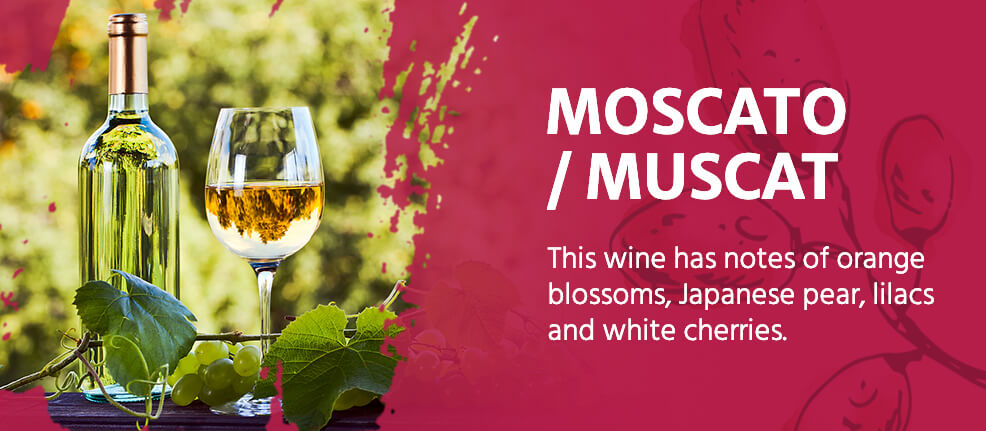
Muscat grapes grow best in warm climates, which is why the grape grows well around the Mediterranean and in some parts of Australia. Notes of orange blossoms, Japanese pear, lilacs and white cherries build its sweet profile without much acidity or residual tang. What’s more, white wine Moscato will also come in “still” or “sparkling” versions, with bubbles adding a textural element that’s great to enhance some appetizers or mains.
Moscatos make for an unrivaled pairing with desserts — something that’s hard to achieve even for other sweet whites. Some of moscato’s best dessert matches include:
- Poundcake
- Vanilla custards and ice creams
- Poached pears
- Dark, semisweet chocolate
Likewise, entrees that go well with these popular white wine types are those with bold flavor profiles that can hold up to its fruity nature, such as:
- Jerk chicken
- Marinated tofu
- Buffalo chicken wings
- Pozole
- Gumbo and jambalaya
8. Semillon
Pronounced “seh-me-yohn”
Semillion white wine is France’s third most-planted vine type. However, few know of its rich, complex flavor profile, have tasted it from a freshly uncorked bottle or have even spotted it on a menu.
Flavor-wise, semillion grapes carry prominent herbaceous notes like a glass of sauvignon blanc while holding a body and acidity closer to a chardonnay. That is, flavors tend to stay longer on the tongue and roof of the mouth, plus leave a more nuanced aftertaste than what you experience at first sip. Some even describe semillion’s texture as oily or waxy, yet its flavors are plump and bright. It’s an impressive dichotomy hard to find in other white varietals.
Don’t let words like “oily” deter you from exploring the rich and singular taste of both Old World and New World semillions. This white wine tends to carry a more decadent, zestier flavor profile than other whites. Semillions cultivated in warm climates like South Africa and Argentina produce mango, papaya and white pepper bits. Cooler-climate varieties allow acidity levels to linger, tasting of lime, fig and ginger.
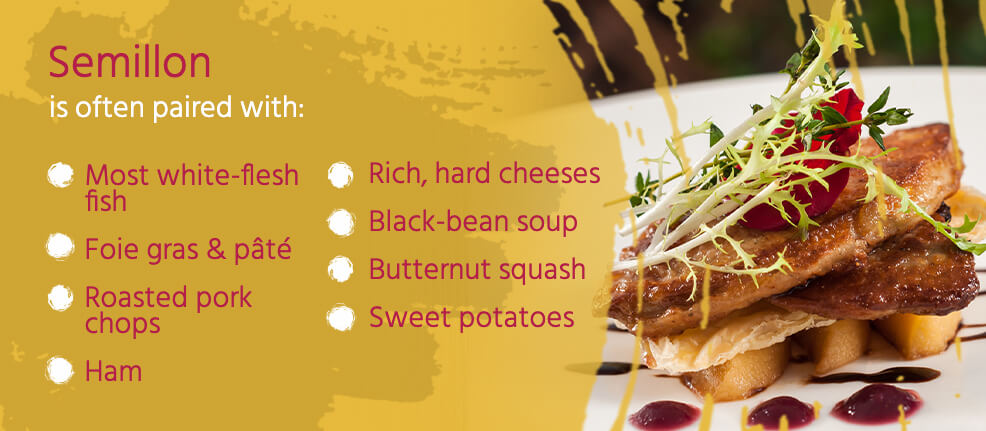
Semillion’s strong up-front expressions but toned-down aftertaste make it a suitable pairing with these dishes:
- Nearly any white-flesh fish
- Foie gras and pâté
- Roasted pork chops
- Ham
- Rich hard cheeses, like cheddar and gruyere
- Black-bean soup
- Butternut squash
- Sweet potatoes
9. Viognier
Pronounced “vee-oh-nay”
Viognier is hardly ever the talk of the town, even though it’s one of the most prototypical of white varietals.
For those drawn to the naturally lush, light, floral and acidic features so tied to white wines, viognier is heaven in a glass. The nose hits you with perfumed, bouncy and airy floral aromas. Viognier’s full-bodied, full-fruit tastes enhance these notes by hitting the roof of your mouth and staying there until your next sip.
In many aspects, viogniers are the older, perhaps “nicer” twin sister to the chardonnay. Their origins sweep back to ancient vineyards planted by the Romans across parts of their Eastern and Western European empires. But, viognier’s lush, low-yield grapes were the rarer, more prized growth. That attitude has carried over into today, as viogniers only have about 30,000 acres of vines worldwide.
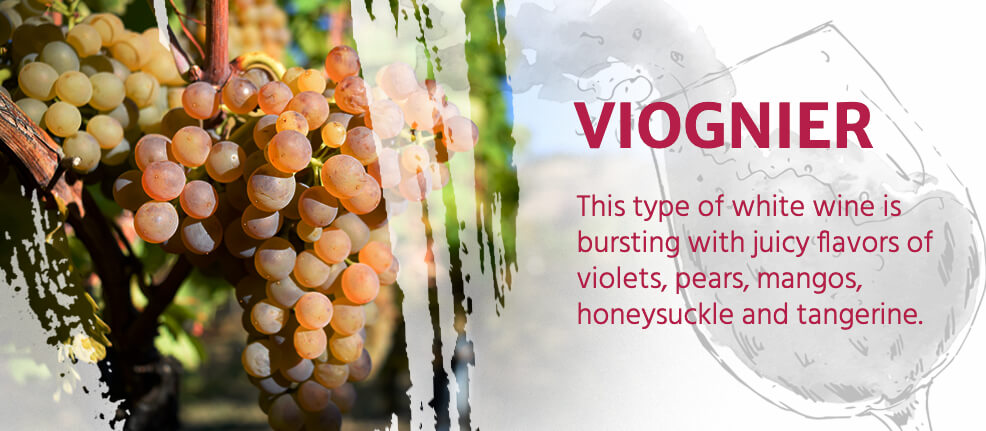
Nowadays, you don’t have to be part of society’s gentry to find and enjoy good bottles of viognier. This type of white wine is soft and fruity, with less weight on the tongue than other whites but bursting with juicy flavors of violets, pears, mangos, honeysuckle and tangerine. With less acidity than a chardonnay, you can expect these flavors to succeed with a smooth, clean finish with aftertastes dependent on whether the bottle was age-oaked. Unoaked viogniers will keep their peach-and-apricot-light finish, while those aged in oak temper fruity acidity to produce a spiced, semi-dry clove and vanilla finish.
Highlight this underappreciated type of white wine at your next meal that contains any of the following:
- Shellfish, especially lobster
- Seared scallops
- Orange chicken
- Roasted chicken or pork chops
- Meat or vegetable lo mein
- Fried rice
- Soft, warm cheeses like fondue or brie
- Polenta
- Citrus fruits, especially oranges and apricots
10. Cortese
Pronounced “core-tay-zee”
A glass of cortese is the perfect white wine to sip after a long day. It’s crisp, tart, structured and flavorful, hitting rounded notes of herbs, musk and fruit alike. It’s also yet another white wine that doesn’t get the praise it deserves — perhaps because of its highly regional growths and the limited number of vineyards that nail its temperamental nature.
While cortese grapes are some of the highest-yielding vines in existence, they require a particularly warm atmosphere that slowly develops their fruit. The heat allows the grapes’ sugars to ripen and produce more complex flavors, not merely lending a hit-and-run acidity punch. However, with too much warmth, the cortese grapes reach maturity without this necessary sugar balance, striking more sour notes that require tempering with malolactic fermentation methods.
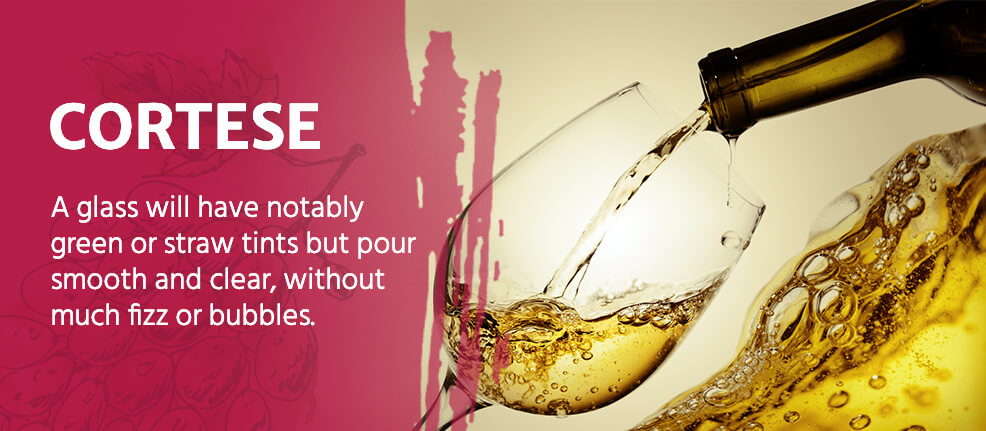
The best cortese wines come from the Piedmont and Lombardy regions of northern Italy. A glass will have notably green or straw tints but pour smooth and clear, without much fizz or bubbles. Cortese checks all the white-wine flavor boxes, carrying flavors of lime, banana, passion fruit, mulch and campfire smoke. They’ll finish with an uptick of acidity that plays on the back of the tongue and stays there, all due to the wine’s viscosity and almost fatty feel in the mouth.
Cortese’s abundance of flavors and rich, luxurious finish will amplify many dishes with robust, fresh profiles:
- Bruschetta and Caprese salads
- Antipasto
- Tuna tartare
- Pesto sauces
- Enchiladas
- Clams and mussels
- Crab rolls or salad
- Most chicken dishes
- Margherita pizza
11. Torrontés
Pronounced “torr-ron-tace”
Torrontés is an aromatic white wine that primarily comes from Argentina’s northern regions. When you pour a glass of torrontés, you can smell a sweet floral aroma of roses and geraniums and taste notes of white peach and lemon zest. Most torrontés wine is dry, despite its sweet smell. If you’re a fan of a dry riesling, torrontés is a must-try due to the similarities between the two wines. While it’s a dry wine without much residual sugar, the sweet aroma plays on its dryness and adds a light jovialness to the wine.
You can expect to pay anywhere from $8 to $12 for a high-quality bottle of torrontés wine.
The light aromatic nature and dryness of a torrontés pair well with heavily spiced meals and light meats and fishes, such as:
- Roast chicken
- Coconut curry
- Glazed tofu
- Chana masala
- Barbecue pork
- Blackened tilapia
- Mature goat cheeses like chevre and brie
- Herbs and spices such as cilantro, basil, mint, jalapeno, cayenne, turmeric and cumin
- Hearty vegetables like squash, potato, carrot and onion
12. Albariño
Pronounced “al-bree-now”
Albariño originates in the Rìas Baixas region of Spain and regions of Portugual. Although Spain is known internationally for red wines, Albriño is considered Spain’s premier white grape.
This coastal white is refreshing and zippy, with notes of grapefruit and lime. You can experience notes of orange zest, honeysuckle and nectarine with whiffs of Thai basil. Each subtly salty glass is perfect for seafood plates and other aromatic meals.
Enjoy albariño with one of these flavor-filled dishes:
- Flaky fish
- Guada
- Soft cheeses such as burrata
- Salty feta
- Manchego
- Grilled padrón
- Caprese and Cesar salads
13. Chenin Blanc
Pronounced “cheh-nuhn blahnk”
Chenin blanc has a delicious range from sparkling to dry, making this an excellent addition to your wine cabinet and diner table. The grape that creates this wine is incredibly versatile, able to form fully sweet or bone dry bottles. Chenin blanc can rival chardonnay when oak aged, and the grape is believed to be a sibling of sauvignon blanc.
It has honeyed aromas and a rich taste with an excellent balance of sweetness and acidity. Chenin blanc is popular in South Africa, where it’s blended with marsanne, viognier and semillion. You can taste undertones of yellow apple, chamomile, pear, honey and quince in an aromatic glass of this acidic wine.
Pair your glass of chenin blanc with these delectable dishes:
- Honey baked ham
- Pig roast
- Cajun jambalaya
- Biltong
- Apple chutney
- Rice balls
White Wine Frequently Asked Questions
A glass of white wine can complete a delicious dish and bring elegance and flavor to a dish. If you’re trying to determine what pairing would be best for you, we’ve answered some frequently asked questions so you have everything you need to know about white wines.
Is White Wine Sweet or Dry?
Although many whites are dry, white wines tend to provide more sweet flavors than red wines. The acidity of white wines makes them less sweet, but you can identify sweet or dry wines from labels, such as semi-sweet and off-dry.
Which White Wines Are Considered Dry?
Residual sugar classifies wine as sweet or dry. Pinot grigio, albriño and sauvignon blanc tend to be dry. Other white wines like New World chardonnays and rieslings can fall between off-dry and dry. Although some of these can also create sweet blends, you can identify whether they’re dry by the amount of sugar.
Which White Wines Are Sweet?
Sweet wines tend to be fruity, and you can find delectably sweet profiles in moscato, riesling and white zinfandel. These wines have more sugar than dry wines and have a different fermentation process. These wines are less acidic and have fewer tannins.
Is Pinot Grigio or Sauvignon Blanc Sweeter?
White wine differences can be noticeable when comparing a sweet or dry glass. However, some wines are similar in taste, and differences can be challenging to determine. Sauvignon blanc tends to emit a more citrusy aroma, while pinot grigio is typically sweeter. Though both are considered dry wines, pinot grigio tends to be sweeter than sauvignon blanc.
What Is the Most Popular White Wine?
Chardonnay is the most popular white wine. California has dedicated the most vineyards to growing grapes for chardonnay, and the flavors make it easy to see why. The caramel and coconut finishes make this a delectable sweet or dry wine. However, moscato is the most popular sweet white wine.

Marketview Liquor: The Place to Explore White Wines
Whether you’re looking to push your palate, expand your knowledge of all the different white wine types out there or find a Rochester-area wine tasting, Marketview Liquor is here to help. Explore our white wines today, available for online ordering, or pick them up in-store if you are near our Rochester, N.Y. location. We also offer free shipping on select bottles of six or more wines, as well as 10% mix and match case discounts – ideal if you’d like to try a few different wines at once, delivered directly to your door!
There’s a story behind every bottle of white wine and a new world in every sip. Start experiencing them today.
